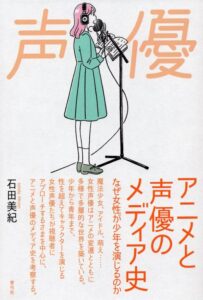
Ishida Minori 石田美紀
Tokyo: Seikyusha (青弓社) 2020.
Reviewed by Liu Yang (PhD candidate, University of Tsukuba, HYI Visiting Fellow)
The past few decades have witnessed voice acting grow into a widely recognized profession in Japan. One distinctive feature of this industry is the tradition of casting female performers in voicing young male characters. While many tend to treat it as a natural, global phenomenon, the book A Media History of Anime and Voice Acting: Why Do Women Play Boys? made clear that this trend originated from specific historical roots, and gives rise to particular media practices and cultures in contemporary Japanese society. The book’s author, Ishida Minori, is a scholar whose research interest involves both voice acting and gender studies.
The book is divided into two sections. The first section (ch1-ch5) offers a detailed historic account of how female performers came to be cast as young male characters, and how this practice became normalized across various media platforms. It is said that during the American occupation of Japan after World WarⅡ, radio dramas were seen as a crucial tool for both entertaining the public and promoting democratization within Japanese society. The diversity of themes and characters, along with the technological and institutional conditions of the time, created numerous opportunities for adult female performers, particularly in voicing young boys (ch1-2). This custom persisted even after television became widespread, though it also introduced new challenges of synchronizing the voices with visual images (ch3-4). However, as noted in ch5, there were also exceptions such as Toei Animation, which implored “stars” and children to voice for their works in the late 1950s and early 1960s.
The second section (ch6-10) went on examining the communication between voice performers and their fans. Roughly following a chronicle order, these chapters reveal two competing tendencies in the perception and consumption of voice acting emerging from the 1970s: the tendency to appreciate voice acting while being aware of the disjunction of the physical appearance between the performer and the character, especially in the cases of voice actresses who play boy characters on the one hand, and the tendency to seek correspondence between the performer and the character on the other. Ishida sharply points out that while the two modes of practice appear to be oppositional, their divergence stems from specific media conditions at the time (such as the magazines’ shaping of readers’ expectations and desires), and both reflect the increasing recognizability of voice acting in mainstream media. Furthermore, she provides a supplementary discussion on the appearance of male performers voicing young male characters since the 2010s, particularly within the genres of BL (boys’ love) drama CDs and situation CDs targeting female audience. According to Ishida, these genres share the same origins and mechanisms as the consumption of male characters voiced by female performers, and offer new insights into the gendered labor of voice acting.
As a student of linguistic anthropology, what I find most inspiring about this book is its exploration of the dynamics of character construction and consumption through voice drawing on the work of Azuma Hiroki (ch8-ch10). 25 years ago, Azuma famously pointed out that it’s no longer the narrative, but rather the character which combines bunches of signs bearing conventionalized meanings that grabs people’s interest. [1] Ishida argues that in terms of boy characters, it is not only graphic signs, but also audio signs provided by the voice actresses – along with the alignment to and/or deviation from their expected meanings – that contribute to contemporary character consumption. This observation resonates with the linguistic anthropological tradition of considering speaking figures as pragmatically constructed social beings rather than static images, thus demonstrating that voice acting is a semiotic process awaiting further investigation from a linguistic/semiotic anthropological perspective.
Overall, A Media History of Anime and Voice Acting is a significant contribution that not only shows us the historical development of key traditions in Japanese voice acting since the end of World WarⅡ, but also demonstrates the importance of exploration into this industry from multiple academic perspectives. Combining a wide range of materials including magazines, anime scripts and interview data, Ishida illustrates the complex sociocultural and semiotic processes underlying voice performance. In this regard, her work deserves both critical acclaim and broader international attention.
[1] Azuma, Hiroki. ‘Dobutsuka-suru Postmodern (Animalizing Postmodern)’, Tokyo: Kodansha, 2001.
